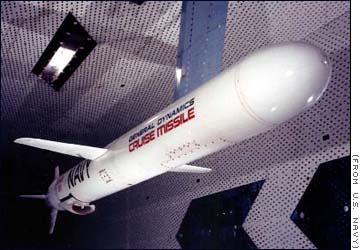
| 
|
Some of the Weapons Used in Sunday's Attacks Against Afganistan: 
Tomahawk Cruise Missile:
A long-range, jet-powered cruise missile launched from Navy ships and submarines. First used in the 1991-1992 Persian Gulf War, the missile has since been used several times since, including 1998 attacks on Osama bin Laden's camps in Afghanistan. The missile uses Global Positioning System technology and computer mapping programs to hit its target.
Manufacturer: Raytheon Systems Co.
Engine: Turbofan and solid rocket booster
Length: 20 feet, 6 inches with booster, or 18 feet, 3 inches without
Diameter: 20.4 inches
Wingspan: 8 feet, 9 inches
Weight: 2,900 pounds, 3,000 pounds with booster
Cost: $600,000
Range: 1,000 miles
Speed: About 550 mph
First ready for use: 1986
Inventory: Not listed

Joint Direct Attack Munition:
A special kit that fits on the tail of a conventional 1,000-pound or 2,000 pound bomb allowing the bomb to be guided by global positioning systems. The military developed the system after the Gulf War to allow planes to drop conventional bombs during bad weather or from longer distances.
Manufacturer: Boeing
Length (JDAM and warhead): From 119.5 inches to 152.7 inches, depending on size of bomb
Wingspan: Either 25 inches or 19.6 inches
Weight: Between 1,013 pounds and 2,115 pounds
Wingspan: 19.6 inches to 25 inches
Range: 15 miles
Ceiling: 45,000-plus feet
Cost: About $21,000 per kit
Range: Up to 15 miles
First deployed: 1999
Inventory: Projected total, 87,496 Air Force, 62,000; Navy, 25,496

B-1B Lancer:
A long-range bomber which can fly around-the-world missions. First built to carry nuclear bombs, now used to unleash conventional bombs. First used in combat to support operations against Iraq in 1998 during Operation Desert Fox.
Manufacturer: Boeing, formerly Rockwell International
Engines: Four turbofans with afterburners
Length: 146 feet
Wingspan: 137 feet, with wings extended forward; 79 feet with wings swept back
Speed: More than 900 mph
Range: Intercontinental
Weapons: Up to 80 conventional bombs, 30 cluster bombs, 24 guided "smart" bombs
First deployed: 1985
Crew: Four (aircraft commander, pilot, offensive weapons officer, defensive weapons officer)
Cost: $200 million
Inventory: 51 battle-ready bombers in Air Force, another 18 in the Air National Guard

B-2 Spirit:
Also known as the "stealth" bomber, the B-2's "flying wing" shape, special materials and other measures are designed to make it difficult for enemy radar to track.
Manufacturer: Northrop Grumman Corp.
Engines: Four turbofans
Length: 69 feet
Wingspan: 172 feet
Speed: High subsonic (less than 750 mph)
Range: 7,255 miles
Weapons: 40,000 pounds of bombs
First deployed: 1993
Crew: 2 (Pilot and mission commander)
Cost: About $1.3 billion each
Inventory: 21 (1 test)

B-52 Stratofortress:
The B-52 is the U.S. Air Force's workhorse bomber, able to drop or fire a wide variety of bombs and missiles. B-52s dropped 40 percent of the ordinance on Iraq during the Gulf War. With airborne refueling, the planes can fly around the world. During the Gulf War, for instance, B-52s took off from Barksdale Air Force Base, La., fired missiles at Iraq, and returned home in marathon 35-hour missions.
Manufacturer: Boeing
Engines: Eight Pratt & Whitney turbofans
Length: 159 feet, 4 inches
Wingspan: 185 feet
Speed: 650 mph
Range: 8,800 miles without refueling
Weapons: 70,000 pounds of ordinance, which can include bombs, mines and missiles
First deployed: 1955
Crew: Five (aircraft commander, pilot, radar navigator, navigator and electronic warfare officer)
Cost: $74 million
Inventory: Air Force active, 85; Air Force Reserve, 9

| 
| 
|

